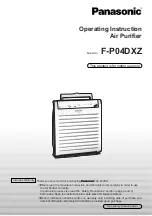
23
GENERAL SERVICE GUIDE Continued
SYMPTOM POSSIBLE
METHOD
OF
FINDING
Running Cycle
Too Long Or Unit
Operates
Continuously.
Refrigerant undercharged.
Dirty filter or evaporator coil.
Dirty or clogged condenser coil.
Air or other non-condensables in system.
Defective compressor.
Restriction in suction and liquid line.
Control contacts stuck.
Check subcooling.
Check filter, coil and airflow.
Check coil and airflow.
Check equalized high side pressure with equivalent outdoor temperature.
See above – high suction pressure.
Check for restrictions in refrigerant circuit.
Check thermostat, shorts in wiring, slave relay compressor contactor.
Supply Air
Temperature
Too High.
Refrigerant undercharge or leak in system.
Evaporator plugged with dirt or ice.
Improperly adjusted or defective expansion valve.
Defective compressor.
High discharge pressure.
Airflow is too high.
Check subcooling and check for leaks.
Check evaporator, airflow and filter.
Check superheat and adjust TXV, check bulb.
Check compressor for proper operation.
See above- high discharge pressure.
Check external static pressure.
Supply Air
Temperature
Too Low.
Airflow is too low.
Return air temperature too low.
Check evaporator coil, filter, check for closed dampers, grills, drive for loose parts,
belts, misalignment, check external static pressure.
Check entering air wet bulb conditions.
Liquid Line
Too Hot.
Refrigerant undercharged.
High discharge pressure.
Charge by subcooling.
See above – high discharge pressure.
Liquid Line
Frosted Or Wet.
Restriction in liquid line.
Restriction upstream at point of frosting.
Suction Line
Frosting.
Insufficient evaporator airflow.
Restriction in suction or liquid line.
Malfunctioning or defective expansion valve.
Check airflow, check drive for loose parts, belts, closed dampers.
Restriction upstream at point of frosting.
Check bulb of TXV.
Blower Motor
Not Running.
Improper wiring.
Defective motor.
Defective thermostat or control circuit.
Motor off on overload protector.
Check wiring diagram.
Check motor controller.
Check “R” and “G” Circuit.
Allow motor to cool, check amperage.
Summary of Contents for RCA051
Page 8: ...8 DIMENSIONS...
Page 9: ...9 DIMENSIONS Continued...
Page 10: ...10 DIMENSIONS...
Page 11: ...11 DIMENSIONS Continued...
Page 14: ...14 TYPICAL FIELD WIRING DIAGRAM...
Page 17: ...17 FIELD WIRING DIAGRAM...
Page 24: ......
Page 26: ...26 NOTES...
Page 27: ...27 NOTES...
Page 28: ...28...






































